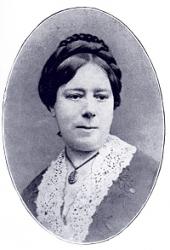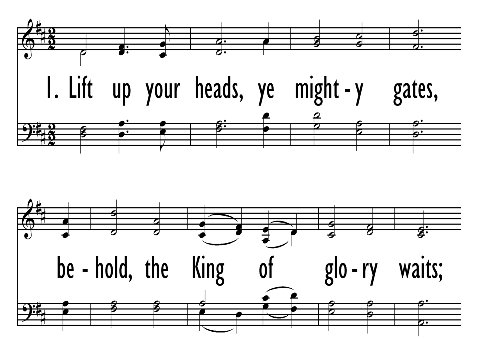- |
User Links
Lift Up Your Heads, Ye Mighty Gates

Lift up your heads, ye mighty gates, Behold the King of glory waits
Author: Georg Weissel (1642); Translator: Catherine Winkworth (1855)Published in 279 hymnals
Printable scores: PDFPlayable presentation: Lyrics only, lyrics + musicAudio files: MIDI, Recording
Representative Text
1 Lift up your heads, ye mighty gates;
behold, the King of glory waits;
the King of kings is drawing near;
the Savior of the world is here!
2 Fling wide the portals of your heart;
make it a temple, set apart
from earthly use for heaven's employ,
adorned with prayer and love and joy.
3 Redeemer, come, with us abide;
our hearts to thee we open wide;
let us thy inner presence feel;
thy grace and love in us reveal.
4 Thy Holy Spirit lead us on
until our glorious goal is won;
eternal praise, eternal fame
be offered, Savior, to thy name!
United Methodist Hymnal, 1989
Author: Georg Weissel
Weissel, Georg, son of Johann Weissel, judge and afterwards burgomaster at Doranau, near Königsberg, was born at Domnau in 1590. He studied at the University of Königsberg, from 1608 to 1611, and thereafter, for short periods, at Wittenberg, Leipzig, Jena, Strassburg, Basel and Marburg In 1614 he was appointed rector of the school at Friedland near Domnau, but resigned this post after three years, and returned to Königsberg to resume his studies in theology. Finally, in 1623, he became pastor of the newly erected Altrossgart church at Königsberg, where he remained till his death, on August 1, 1635. Weissel was one of the most important of the earlier hymn-writers of Prussia. His hymns, about 20 in all, are good in style, moderate in le… Go to person page >Translator: Catherine Winkworth
 Catherine Winkworth (b. Holborn, London, England, 1827; d. Monnetier, Savoy, France, 1878) is well known for her English translations of German hymns; her translations were polished and yet remained close to the original. Educated initially by her mother, she lived with relatives in Dresden, Germany, in 1845, where she acquired her knowledge of German and interest in German hymnody. After residing near Manchester until 1862, she moved to Clifton, near Bristol. A pioneer in promoting women's rights, Winkworth put much of her energy into the encouragement of higher education for women. She translated a large number of German hymn texts from hymnals owned by a friend, Baron Bunsen. Though often altered, these translations continue to be used i… Go to person page >
Catherine Winkworth (b. Holborn, London, England, 1827; d. Monnetier, Savoy, France, 1878) is well known for her English translations of German hymns; her translations were polished and yet remained close to the original. Educated initially by her mother, she lived with relatives in Dresden, Germany, in 1845, where she acquired her knowledge of German and interest in German hymnody. After residing near Manchester until 1862, she moved to Clifton, near Bristol. A pioneer in promoting women's rights, Winkworth put much of her energy into the encouragement of higher education for women. She translated a large number of German hymn texts from hymnals owned by a friend, Baron Bunsen. Though often altered, these translations continue to be used i… Go to person page >Text Information
Related Texts
| First Line: | Lift up your heads, ye mighty gates, Behold the King of glory waits |
| Title: | Lift Up Your Heads, Ye Mighty Gates |
| German Title: | Macht hoch die Tür |
| Author: | Georg Weissel (1642) |
| Translator: | Catherine Winkworth (1855) |
| Meter: | 8.8.8.8.8.8.6.8 |
| Language: | English |
| Copyright: | Public Domain |
Chinese
English
- A Book of Chorales: And supplemental hymns #30
- A New Hymnal for Colleges and Schools #30
- African Methodist Episcopal Church Hymnal #94
- Ambassador Hymnal: for Lutheran worship #1
- American Lutheran Hymnal #330
- Anglican Hymns Old and New (Rev. and Enl.) #438
- At Worship: a hymnal for young churchmen #143
- Baptist Hymnal 1956 #247
- Baptist Hymnal 1991 #128
- Book of Hymns for the Evangelical Lutheran Joint Synod of Wisconsin and Other States #d139 10 shown out of 202
Notes
Access an additional article on the Canterbury Dictionary of Hymnology:
Tune
TRURO (Williams)TRURO is an anonymous tune, first published in Thomas Williams's Psalmodia Evangelica, (second vol., 1789) as a setting for Isaac Watts' "Now to the Lord a noble song." Virtually nothing is known about this eighteenth-century British editor of the two-volume Psalmodia Evangelica, a collection of thr…
MACHT HOCH DIE TÜR (Freylinghausen)
Tune MACHT HOCH DIE TÜR, DIE TOR MACHT WEIT from J.A. Freylinghausen’s Geist-reiches Gesang-Buch (1704), arr. as in The Lutheran Hymnal (1941).
For Leaders
Text:
Georg Weissel, a seventeenth-century German pietist, is the author of the original text for this hymn based on Psalm 24. Written for the first Sunday of Advent, it was first published in Preussiche Fest-Lieder in 1642. Catherine Winkworth translated it into English and published it in her Lyra Germanica in 1855. She revised her translation for publication in her Chorale Book for England in 1863.
Both the German original and Winkworth’s translation were in five eight-line stanzas in the meter 8.8.8.8.8.8.6.6. Since Winkworth’s translations were published, many different versions have appeared. Sometimes each stanza is divided into two four-line stanzas of 8.8.8.8, for which the last two lines of each eight-line stanza are revised to fit the meter. Hymnals with eight-line stanzas tend to include all five, but those with four-line stanzas usually use less than half of the full text. While the first four lines of the hymn are always included, the only parts of the remaining text that are often used are the original fourth and fifth stanzas.
The declaration of the glory of God the King is the main theme of this hymn. The fifth of the original stanzas is a prayer addressed to God asking for His presence in one’s heart.
Tune:
There are several tunes to choose from in singing this hymn. The most common choice is TRURO, an anonymous tune first published in 1789 in Psalmodia Evangelica by Thomas Williams. It has been attributed to several people, including George F. Handel, but no definite evidence has been found for such claims. This tune is named after a city in Cornwall, but there is no known connection between the two. This tune is in the shorter meter, as is WAREHAM.
The second most popular tune is MACHT HOCH DIE TÜR, named after the German text of the hymn. It is in the longer meter, like the original text of the hymn and the alternate tune MILWAUKEE. An interesting fact is that Lutheran hymnals that include this hymn tend to have two settings, one for each of these longer tunes.
When/Why/How:
This hymn was originally written for Advent, but is also used for Palm Sunday. In either season, this hymn is appropriate for hailing the coming of King Jesus. Two instrumental arrangements designed for these seasons are “Ride On!”, a medley of three Palm Sunday tunes for handbells or handchimes with TRURO, and the arrangement of MACHT HOCH DIE TÜR in “Seven Christmas Fantasias for Piano with Violin.” To add interest to congregational accompaniment, “Introductions, Interludes, and Codas, set 4” for organ includes two settings of MILWAUKEE and one of WAREHAM. A choral arrangement that fully exploits the majestic theme of the hymn is “He Is the King of Glory,” which combines two texts based on Psalm 24 – this hymn (set to TRURO) and George F. Handel’s majestic chorus “Lift Up Your Heads” from Messiah, which has the same opening rhythmic motif as TRURO.
Tiffany Shomsky, Hymnary.org
Timeline
Arrangements
Media
The United Methodist Hymnal #213
- MIDI file from Baptist Hymnal 1991 #128
- Audio recording from Baptist Hymnal 1991 #128
- MIDI file from Baptist Hymnal 1991 #128
- MIDI file from The Cyber Hymnal #4076
- Audio recording from Glory to God: the Presbyterian Hymnal #93
- Audio recording from Trinity Hymnal (Rev. ed.) #198
- MIDI file from The United Methodist Hymnal #213
- Audio recording from The United Methodist Hymnal #213
- MIDI file from Worship and Rejoice #176


 My Starred Hymns
My Starred Hymns





